
Theory of everything.
- Subject:
- Mathematics
- Physical Science
- Physics
- Material Type:
- Textbook
- Author:
- Andrej Poleev
- Date Added:
- 09/08/2018


Theory of everything.
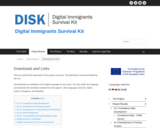
This webpage provides all downloads of the Erasmus+ DISK project 2019-1-PT01-KA204-060898.
These deliverables are available in the English language (in any case). You may switch the language and download the translated material from the pages in other languages (German, Italian, Greek, Portuguese, and Swedish).
The major results are 5 different IOs:
IO 01: Competence Map
IO 02: Development of the learning content
IO 03: Links to the training models (direct open access provided in English language)
IO 04: OERs - descriptions
IO 05: Transferability and Implementation Guide
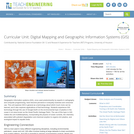
Geographic information systems (GIS), once used predominantly by experts in cartography and computer programming, have become pervasive in everyday business and consumer use. This unit explores GIS in general as a technology about which much more can be learned, and it also explores applications of that technology. Students experience GIS technology through the use of Google Earth on the environmental topic of plastics in the ocean in an area known as the Great Pacific Garbage Patch. The use of this topic in GIS makes the unit multidisciplinary, incorporating the physics of ocean currents, the chemistry associated with pollutant degradation and chemical sorption to organic-rich plastics, and ecological impact to aquatic biota.

It is a multilingual Learning Management System developed with the aim to equip learners with knowledge, abilities and skills that allow them to enter the entrepreneurial world, via Industry 4.0 and Drone Technology, in order to yield the related opportunities. It includes a course, trainer guidelines, evaluation tools and e-learning platform.
The course includes 12 chapters on topics relevant to Industry 4.0 and Drone Technology and it's available in 5 languages (EN, RO, PL, GR, IT), free and easily accessible.
eduDrone LMS link: https://edudrone-project.eu/lms/
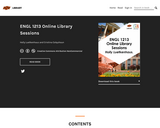
Word Count: 2644
(Note: This resource's metadata has been created automatically by reformatting and/or combining the information that the author initially provided as part of a bulk import process.)

ESCOLAR aims to offer ALL elementary and middle-school students the opportunity to learn science within an engaging online environment.
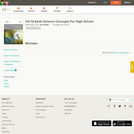
CK-12 Earth Science For High School covers the study of Earth - its minerals and energy resources, processes inside and on its surface, its past, water, weather and climate, the environment and human actions, and astronomy.
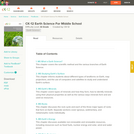
CK-12 Earth Science For Middle School covers the study of Earth - its minerals and energy resources, processes inside and on its surface, its past, water, weather and climate, the environment and human actions, and astronomy.
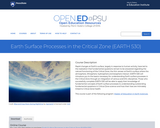
Rapid changes at Earth's surface, largely in response to human activity, have led to the realization that fundamental questions remain to be answered regarding the natural functioning of the Critical Zone, the thin veneer at Earth's surface where the atmosphere, lithosphere, hydrosphere and biosphere interact. EARTH 530 will introduce you to the basics necessary for understanding Earth surface processes in the Critical Zone through an integration of various scientific disciplines. Those who successfully complete EARTH 530 will be able to apply their knowledge of fundamental concepts of Earth surface processes to understanding outstanding fundamental questions in Critical Zone science and how their lives are intimately linked to Critical Zone health.
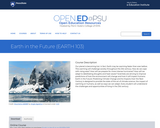
Our planet is becoming hot. In fact, Earth may be warming faster than ever before. This warming will challenge society throughout the 21st century. How do we cope with rising seas? How will we prepare for more intense hurricanes? How will we adapt to debilitating droughts and heat waves? Scientists are striving to improve predictions of how the environment will change and how it will impact humans. Earth in the Future: Predicting Climate Change and Its Impacts Over the Next Century is designed to provide the state of the art of climate science, the impact of warming on humans, as well as ways we can adapt. Every student will understand the challenges and opportunities of living in the 21st century.
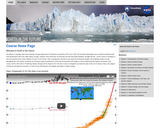
Our planet is becoming hot. In fact, Earth may be warming faster than ever before. This warming will challenge society throughout the 21st century. How do we cope with rising seas? How will we prepare for more intense hurricanes? How will we adapt to debilitating droughts and heat waves? Scientists are striving to improve predictions of how the environment will change and how it will impact humans. Earth in the Future: Predicting Climate Change and Its Impacts Over the Next Century is designed to provide the state of the art of climate science, the impact of warming on humans, as well as ways we can adapt. Every student will understand the challenges and opportunities of living in the 21st century.
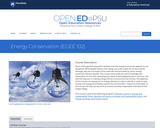
Much of the general population believes that the energy sources we depend on are perpetual. While people believe that energy use is the culprit for environmental damage, they are not aware of the methods and principles by which energy conversion devices operate. This course will provide you with knowledge and information on the main operating principles of devices/appliances in common use and will help you in making energy efficient and economical choices. The objective of the course is to expose you to energy efficiency in day to day life in order to save money and energy and thereby protect the environment. I hope the information in this course will help you become an environmentally-responsible individual of this Global Village.
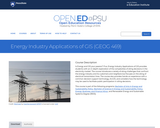
Is Energy and GIS your passion? If so, Energy Industry Applications of GIS provides students with an in-depth exploration of the complexities of siting decisions in the electricity market. The course introduces a variety of siting challenges that confront the energy industry and its customers and neighbors but focuses on the siting of electrical transmission lines. The course also provides hands-on experience with a common decision support technology, ArcGIS, and considers how the technology may be used to facilitate public participation in siting decisions.
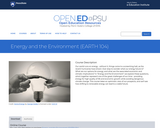
Our world runs on energy - without it, things come to a screeching halt, as the recent hurricanes have shown. Ever stop to wonder what our energy future is? What are our options for energy, and what are the associated economic and climatic implications? In \Energy and the Environment\" we explore these questions, which together represent one of the great challenges of our time - providing energy for high quality of life and economic growth while avoiding dangerous climate change. This course takes an optimistic view of our prospects, and we'll see how shifting to renewable energy can lead to a viable future.
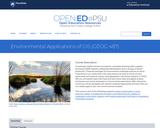
Increasingly volatile climate and weather; vulnerable drinking water supplies; shrinking wildlife habitats; widespread deforestation due to energy and food production. These are examples of environmental challenges that are of critical importance in our world, both in far away places and close to home, and are particularly well suited to inquiry using geographic information systems. In GEOG 487 you will explore topics like these and learn about data and spatial analysis techniques commonly employed in environmental applications. After taking this course you will be equipped with relevant analytical approaches and tools that you can readily apply to your own environmental contexts.
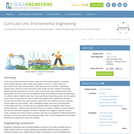
In this unit, students explore the various roles of environmental engineers, including: environmental cleanup, water quality, groundwater resources, surface water and groundwater flow, water contamination, waste disposal and air pollution. Specifically, students learn about the factors that affect water quality and the conditions that enable different animals and plants to survive in their environments. Next, students learn about groundwater and how environmental engineers study groundwater to predict the distribution of surface pollution. Students also learn how water flows through the ground, what an aquifer is and what soil properties are used to predict groundwater flow. Additionally, students discover that the water they drink everyday comes from many different sources, including surface water and groundwater. They investigate possible scenarios of drinking water contamination and how contaminants can negatively affect the organisms that come in contact with them. Students learn about the three most common methods of waste disposal and how environmental engineers continue to develop technologies to dispose of trash. Lastly, students learn what causes air pollution and how to investigate the different pollutants that exist, such as toxic gases and particulate matter. Also, they investigate the technologies developed by engineers to reduce air pollution.
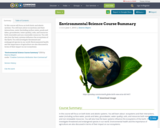
In this course will focus on both biotic and abiotic systems. You will learn about ecosystems and their interactions, water (including surface water, ponds and lakes, groundwater, water quality), soils, and resources both renewable and non-renewable resources. You will also how the basic systems influence the ecosystems of the Earth. You will investigate threatened and endangered species in our world. Environmental health and the importance of agriculture are also discussed in terms of their impact on our ecosystems.

This is a collection of the results of the Erasmus+ project GAMMA: GAMe-based learning in MAthematics. In the GAMMA project, we have developed education materials for mathematics teachers who want to integrate GBL founded on digital technology effectively into their teaching practice. The materials could also be useful for teachers of other subjects who wish to integrate this method into their teaching. The authors are team members from GAMMA partner institutions.

The year is 2050 and your once-idyllic beachfront vacation home is now flooded up to the second story. The crab your family has enjoyed every Christmas for as long as you can remember has now become an endangered species. The oceans have changed. In Earth 540, Oceanography for Educators, we explore the mechanisms that lead to sea level rise and ocean acidification. We strive to understand how natural processes such as ocean currents, the gulf-stream, tides, plate tectonics, and the Coriolis Effect, affect our oceans and ocean basins. We then predict how man-made issues such as climate change and overfishing will affect our beloved waters and our livelihoods. Want to see into the future? Then this course is for you!
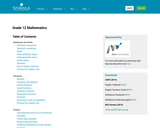
This is a comprehensive math textbook for Grade 12. It can be downloaded, read on-line on a mobile phone, computer or iPad. Every chapter has links to on-line video lessons and explanations. Summary presentations at the end of each chapter offer an overview of the content covered, with key points highlighted for easy revision. Topics covered are: language of mathematics, logarithms, sequences and series, finance, factorising cubic polynomials, functions and graphs, differential calculus, linear programming, geometry, trigonometry, statistics, combinations and permutations. This book is based upon the original Free High School Science Text series.